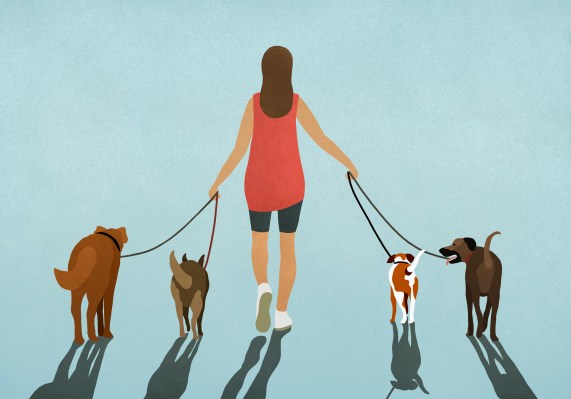Wag!, the petcare company known for connecting pet owners with local dog walkers, has recently undergone a series of sweeping changes.
In late November, after I was named the new CEO, my management team and I began plotting a radically different path to profitability. We began by assessing our relationship with users. First and foremost, we recognized that Wag! needed to improve the way we supported the community, including pet parents, pet caregivers and their pets.
Next, we examined the company’s financial health and analyzed the competitive climate, investment community and direction in which the tech industry appeared headed. The time has come to share how this influenced our decisions.
Late in 2019, a lot of smart people began to note a philosophical shift taking place in the capital markets. Investors had begun to lose patience with startups that spent massive sums on acquiring market share, but had demonstrated little to no ability at creating lasting businesses.
We concluded that funding in some sectors would quickly dry up. Based on our analysis, we expect a growing number of startups will be forced to hew out self-sustaining business niches to survive. This assessment is partly what led us to conclude that accepting another funding round wouldn’t necessarily benefit the company in the area that matters most: providing value to customers.
A consensus formed after we took control, and found a constant drumbeat of bills coming in and payments going out, notably to Amazon (Web Services), Google (to help extend our brand), Facebook (to reach customers) and for our office space. These costs were growing faster than revenue.
The management team agreed that we didn’t need more funding, just to watch it go out again in the name of marketing or branding. We knew we needed to improve service quality, and that required dedicating more resources to research & development and constant iteration.
Instead of accepting more investment, we chose to cut costs. This included a consolidation of some of our offices and a painful 76% reduction of our workforce. We accomplished this within 90 days. These were difficult decisions, but absolutely essential for Wag!’s long-term viability.
We began the analysis to understand why investors had lost confidence in certain categories. We learned that billions of dollars flowed into many business segments that proved too small to produce worthwhile returns.
We also observed how some struggling high-profile startups lacked network effects, the benefit a service or product derives when the number of customers, or suppliers, increases. For example, when a new merchant sells goods via Amazon, customers benefit by having greater selection. The new retailer benefits by acquiring access to more consumers.
Buying from Amazon is easier because the merchant offers all the goods people want, as well as delivery. Transacting is simple because the company possesses the necessary customer information. For services that establish a two-sided network effect, where enough buyers and sellers exist to create liquidity, they tend to be hard to compete against.
In contrast, numerous startups appear to have never hit on a legitimate value proposition for consumers. They never solved a problem that enough people cared about. Instead, many propped up revenue and traffic numbers by offering discounts or giveaways. When the marketing money ran out, products returned to full price and sales plunged.
In addition, empty coffers create new challenges. Managers often can’t rein in their spending. A CEO who is accustomed to paying $5 million for marketing may view a $100,000 bill for creative services as inconsequential. But when markets contract, history tells us fiscal discipline can mean life or death for startups.
Now, with the economy in turmoil and a recession looming, we believe we’re better positioned to weather whatever economic conditions may come. Nobody knows the future, but of this we’re sure: The frothy period of excitement over the previous class of tech startups has ended.
What does all this mean for Wag!?
First, we have a head start in right-sizing the company. After reducing our operating expenses by more than 80%, we have the resources to last us for the foreseeable future. Our brand and customer following are strong. Because of the choices we have made and our renewed commitment to users and pets, Wag! has a clear line to become cash-flow positive.
We’ve carefully chosen where to invest our resources. We’re leveraging our software to improve our ability to connect the best pet caregivers with a growing number of pet parents. From this time forward, all our spending, infrastructure and manpower are dedicated to supporting our customers and protecting their pets.
James Currier, managing partner at venture capital firm NFX, says what’s most important is “getting your spending under control and getting the right people in the room. You don’t need everybody. You just need the right people. WhatsApp with only 50 employees sold for $20 billion to Facebook. So, it can be done — if you have a good product and you have a network effect.”
By 2023, some estimates see the pet care industry generating as much as $281 billion. Research shows that young people are waiting longer to have kids, and, in the interim, they are turning to dogs for companionship. That’s a market-level trend that will continue to benefit us. We have a big opportunity in front of us.
Our long-term view is that plenty of companies have endured challenging market trends by right sizing and zeroing in on their customers. Netflix, Dropbox and Amazon are just a few that come to mind.
We believe that the increased focus on our technology and service while reducing our cost structure creates the foundation for a healthier business. Wag! is now better positioned to thrive long term.
